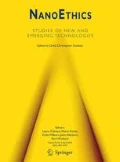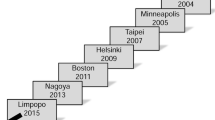Abstract
Nanotechnology has revolutionized various industries and has become a notable catalyst for economic growth. The emerging issues of human health and safety associated with nanotechnology development have raised regulatory concerns worldwide. In occupational settings, the same novel characteristics of nanomaterials that are utilized for innovation may also be the source of toxins with adverse health effects for workers. The existing regulatory framework may function effectively to regulate chemical substances in their conventional forms but may not be adequate with regard to the specific issues of nanoform substances. A foundation of knowledge concerning properties of nanomaterials, and risk management approaches for these materials have been established, but conclusive results remain elusive. It is difficult for lawmakers to regulate nanotechnology-related activities effectively if conventional regulatory mechanisms are applied. The present article analyses in a country study the adequacy of existing Malaysian occupational safety and health law with regard to the specific issues presented by nanotechnology. The applicable regulatory approaches are examined to justify the adoption of soft law instruments as regulatory mechanisms for nanotechnology. A number of soft law best practices are briefly discussed as a basis to recommend practical solutions to close the existing regulatory gap.
Similar content being viewed by others
Notes
Section 4, OSHA 1994
Section 15(1), OSHA 1994
Section 1, OSHA 1994
Part II, USECHH Regulation 2000
Part III, USECHH Regulation 2000
Part IV, USECHH Regulation 2000
Part V, USECHH Regulation 2000
Part VI, USECHH Regulation 2000
Part VII, USECHH Regulation 2000
Part VIII, USECHH Regulation 2000
Part IX, USECHH Regulation 2000
Regulation 3, USECHH Regulation 2000
Regulation 2, USECHH Regulation 2000
Regulation 2, CLASS Regulation 2013
Part II, CLASS Regulation 2013
Part III, CLASS Regulation 2013
Part IV, CLASS Regulation 2013
Part V, CLASS Regulation 2013
Regulation 14, CLASS Regulation 2013
Section 24(1) OSHA 1994
Section 30 OSHA 1994
Section 2 OSHA 1994
Regulation 2 USECHH Regulation
Regulation 3 CLASS Regulation
Regulation 14 CLASS Regulation
Schedule 1, USECHH Regulation
Regulation 3, Occupational Safety and Health (Control of Industrial Major Accident Hazards) Regulations 1996
Regulation 2(2)(b) CLASS Regulation
Regulation 13 CLASS Regulation
Section 3 OSHA 1994
Section 30 OSHA 1994
Thong Foo Ching & Ors v Shigenori Ono [1998] 4 CLJ 674
Zakaria bin Abdullah & Ors v Lembaga Perlesenan Tenaga Atom & Ors [2013] 5 MLJ 206
Ketua Pengarah Jabatan Alam Sekitar & Anor v Kajing Tubek & Ors and Other Appeals [1997] 4 CLJ 253 CA
Zaifa Otomobil Sdn Bhd v Sarju Khetshi Popat and Anor [2009] MLJU 662
[2008] 2 MLJ 450
References
Allied Market Research (2016) Nanomaterials Market - Global Opportunity Analysis and Industry Forecast 2014-2022. Allied Market Research, September 2016
Peixe TS, de Souza NE, Schofield KL, Arcuri AS, Bulcão RP (2015) Nanotoxicology and exposure in the occupational setting. Occup Dis Environ Med 3(03):35
Howard J, Murashov V (2009) National nanotechnology partnership to protect workers. J Nanopart Res 11(7):1673–1683
Karim ME Munir AB (2015) Nanotechnology: sketching the next big thing in Malaysian context. Nanotechnol Law Bus 12(2):161–172
NanoMalaysia (2014) National Graphene Action Plan 2020. NanoMalaysia Berhad & Agensi Inovasi Malaysia, Kuala Lumpur
StatNano (2019) Nanotechnology patents of 2018 at the USPTO and EPO through the lens of statistics. https://statnano.com/news/65159. Accessed 19 Jan 2019
StatNano (2019) Nanotechnology publications of 2018: an overview. https://statnano.com/news/65056. Accessed 17 Jan 2019
Thompson DK (2011) Small size, big dilemma: the challenge of regulating nanotechnology. Tenn Law Rev 79:621
Snir R (2014) Trends in global nanotechnology regulation: the public-private interplay. Vand J Ent Tech L 17:107
Abbott KW, Marchant GE, Corley EA (2012) Soft law oversight mechanisms for nanotechnology. Jurimetrics:279–312
Thierer AD, Hagemann R, Skees J (2018) Soft law for hard problems: the governance of emerging technologies in an uncertain future. Colorado Technology Law Journal 17(1):37–130
Hodge GA, Bowman DM, Maynard AD (2010) International handbook on regulating nanotechnologies. Edward Elgar Publishing Ltd., Cheltenham
Del Castillo AMP (2013) Nanomaterials and workplace health and safety: what are the issues for workers? European Trade Union Institute, Brussels
Savolainen K, Backman U, Brouwer D, Fadeel B, Fernandes T, Kuhlbusch T, Landsiedel R, Lynch I, Pylkkänen L (2013) Nanosafety in Europe 2015–2025: towards safe and sustainable nanomaterials and nanotechnology innovations. Finnish Institute of Occupational Health, Helsinki
Buzea C, Pacheco I (2018) Toxicity of nanoparticles. In: Pacheco-Torgal F, Diamanti MV, Nazari A, Granqvist CG (eds) Nanotechnology in ecoefficient construction, 2nd edn. Woodhead Publishing, Cambridge, pp 705–754
Oberdörster G, Maynard A, Donaldson K, Castranova V, Fitzpatrick J, Ausman K, Carter J, Karn B, Kreyling W, Lai D (2005) Principles for characterizing the potential human health effects from exposure to nanomaterials: elements of a screening strategy. Part Fibre Toxicol 2(1):8
Schulte P, Geraci C, Murashov V, Kuempel E, Zumwalde R, Castranova V, Hoover M, Hodson L, Martinez K (2014) Occupational safety and health criteria for responsible development of nanotechnology. J Nanopart Res 16(1):1–17
NIOSH (2013) Occupational esposure to carbon nanotubes and nanofibres. Current intelligence Bulletin 65. DHHS (NIOSH) Publication No. 2013-145. https://www.cdc.gov/niosh/docs/2013-145/pdfs/2013-145.pdf. Accessed 20 Nov 2019
International Labour Organization (2008) Seoul Declaration on Safety and Health at Work. Meeting document, (29 June 2008). Seoul, Republic of Korea. https://www.ilo.org/safework/info/promo/WCMS_151736/lang--en/index.htm. Accessed 15 Jan 2019
Aitken RJ, Peters SA, Jones AD, Stone V (2010) Regulation of carbon nanotubes and other high aspect ratio nanoparticles: approaching this challenge from the perspective of asbestos. Int Handb Regul Nanotechnol:205–237
Thye LL (2014) Need for risk governance. In: The Star Malaysia (23 Oct 2014). https://www.pressreader.com/malaysia/the-starmalaysia/20141023/281938836175839. Accessed 10 Jan 2019
Falkner R, Breggin L, Jaspers N, Pendergrass J, Porter R (2010) International coordination and cooperation: the next agenda in nanomaterials regulation. In: Hodge GA, Bowman DM, Maynard AD (eds) International handbook on regulating nanotechnologies. Edward Elgar, Cheltenham, pp 508–524
Johnson VR (2016) Nanotechnology, environmental risks, and regulatory options. Penn State Law Rev 121:471
McAlea EM, Mullins M, Murphy F, Tofail SA, Carroll AG (2016) Engineered nanomaterials: risk perception, regulation and insurance. J Risk Res 19(4):444–460
Brownsword R (2010) The age of regulatory governance and nanotechnologies. In: Hodge GA, Bowman DM, Maynard AD (eds) International handbook on regulating nanotechnologies. Edward Elgar, Cheltenham, pp 60–83
Klinke A, Renn O (2002) A new approach to risk evaluation and management: risk-based, precaution-based, and discourse-based strategies. Risk Anal 22(6):1071–1094
Renn O (2008) Risk governance: coping with uncertainty in a complex world. Taylor & Francis, London
Marchant GE, Wallach W (2015) Coordinating technology governance. Issues Sci Technol 31(4):43
Breggin LK, Carothers L (2006) Governing uncertainty: the nanotechnology environmental, health, and safety challenge. Colum J Envtl L 31:285
Marchant GE, Allenby B (2017) Soft law: new tools for governing emerging technologies. Bull At Sci 73(2):108–114
Arnaldi S (2017) Changing me softly: making sense of soft regulation and compliance in the Italian nanotechnology sector. NanoEthics 11(1):3–16
Abbott KW (2013) Introduction: the challenges of oversight for emerging technologies. In: Marchant GE, Abbott KW, Allenby B (eds) Innovative governance models for emerging technologies. Edward Elgar, Cheltenham, pp 1–16
Organization for Economic Cooperation and Development (2013) International regulatory co-operation: addressing global challenges. OECD Publishing Paris
Bowman DM, Hodge GA (2008) ‘Governing’ nanotechnology without government? Sci Public Policy 35(7):475–487
Fiorino DJ (2010) Voluntary initiatives, regulation and nanotechnology oversight: charting a path. Project on emerging nanotechnologies Pen-19. Woodrow Wilson International Center for Scholars. https://www.nanotechproject.org/process/assets/files/8347/pen-19.pdf. Accessed 4 Jan 2019
Abbott K, Marchant G, Sylvester D (2009) Transnational regulation of nanotechnology: reality or romanticism? In: Hodge GA, Bowman DM, Maynard AD (eds) International handbook on regulating nanotechnologies. Edward Elgar, Cheltenham, pp 525–545
Marchant GE (2014) ‘Soft law’ mechanisms for nanotechnology: liability and insurance drivers. J Risk Res 17(6):709–719
Hoffman SD, Hoffman ME (1980) Use of standards in products liability litigation. Drake Law Rev 30:283
Wernette R (2010) 8 steps to reducing nanotorts in your nanofuture. LAW360. https://www.law360.com/articles/178122/8-steps-to-reducing-nanotortsin-your-nanofuture. Accessed 18 Nov 2019
Koivisto I (2016) The IMF and the transparency turn. Minn J Int'l L 25:381
Meili C, Widmer M (2010) Voluntary measures in nanotechnology risk governance: the difficulty of holding the wolf by the ears. Int Handb Regul Nanotechnol 446:447–149
Department of Occupational Safety and Health (2005) Guidelines on occupational health services. Ministry of Human Resources Malaysia
Hassan KH, Ab Rahman R (2014) Undang-undang keselamatan industri di Malaysia, 2nd edn. Dewan Bahasa dan Pustaka, Kuala Lumpur
Department of Occupational Safety and Health (2014) Industry code of practice on chemicals classification and hazard communication. Ministry of Human Resources Malaysia
Turley A (2019) Results of GHS for nanomaterials project expected this year. Chemical Risk Manager (25 March 2019). https://chemicalwatch.com/crmhub/75364/results-of-ghs-for-nanomaterials-project-expected-this-year. Accessed 25 Nov 2019
Hamzah Z (2005) Biotechnology law & Strategy. Malayan Law Journal, Lexis Nexis
Department of Occupational Safety and Health (2018) Guideline on control and safe handling of nanomaterials. Ministry of Human Resources Malaysia
Fund ED DuPont-Safer Nanotech. http://business.edf.org/projects/featured/past-projects/dupont-safer-nanotech. Accessed 15 Feb 2019
SÜD TV CENARIOS Certifiable Nanospecific Risk Management and Monitoring. http://innovationsgesellschaft.ch/wp-content/uploads/2015/01/CENARIOS_Factsheet_englisch_2015.pdf. Accessed 15 Feb 2019
Read SA, Kass GS, Sutcliffe HR, Hankin SM (2016) Foresight study on the risk governance of new technologies: the case of nanotechnology. Risk Anal 36(5):1006–1024
European Commission (2009) Commission recommendation on a code of conduct for responsible nanosciences and nanotechnologies research & Council conclusions on responsible nanosciences and nanotechnologies research. Directorate-General for Research Science, Economy and Society, Luxembourg
Safe Nano, Responsible NanoCode. https://www.safenano.org/knowledgebase/guidance/codesofconduct/responsible-nanocode/. Accessed 6 Jan 2019
Safe Nano, Current codes of practice/Conduct for working with nanotechnologies. https://www.safenano.org/knowledgebase/guidance/codesofconduct/. Accessed 6 Jan 2019
BASF Code of Conduct. https://www.basf.com/global/en/who-we-are/sustainability/responsible-partnering/nanotechnology/safety/code-of-conduct.html. Accessed 6 Jan 2019
Murashov V, Howard J (2008) The US must help set international standards for nanotechnology. Nat Nanotechnol 3(11):635–636. https://doi.org/10.1038/nnano.2008.323
Murashov V, Schulte P, Geraci C, Howard J (2011) Regulatory approaches to worker protection in nanotechnology industry in the USA and European Union. Ind Health 49(3):280–296
Finger SR, Gamper-Rabindran S (2012) Protecting workers from adverse chemical exposure: do voluntary standards reduce exposure?
Bell C, Marrapese M (2011) Nanotechnology standards and international legal considerations. In: Murashov V, Howard J (eds) Nanotechnology standards. Springer, New York, pp 239–255
World Health Organization (2017) WHO guidelines on protecting workers from potential risks of manufactured nanomaterials. World Health Organization, Geneva
Organization for Economic Cooperation and Development, Publications in the Series on the Safety of Manufactured Nanomaterials. http://www.oecd.org/science/nanosafety/publications-series-safety-manufactured-nanomaterials.htm. Accessed 17 Jan 2019
Organization for Economic Cooperation and Development (2013) OECD countries address the safety of manufactured nanomaterials. http://www.oecd.org/chemicalsafety/oecd-countries-address-the-safety-of-manufactured-nanomaterials.htm. Accessed 17 Jan 2019
Organization for Economic Cooperation and Development, Report of the scientific conference: science based support for regulation of manufactured nanomaterials. http://www.oecd.org/science/nanosafety/prosafe-conference-regulation-of-manufactured-nanomaterials.pdf. Accessed 17 January 2019
Organization for Economic Cooperation and Development, Non-OECD member countries adhering to the OECD system for mutual acceptance of chemical safety data. http://www.oecd.org/chemicalsafety/testing/non-member-adherens-to-oecd-system-for-mutual-acceptance-of-chemical-safety-data.htm. Accessed 17 Jan 2019
International Organization for Standardization, ISO/TC 229 Nanotechnologies. https://www.iso.org/committee/381983.html. Accessed 14 Jan 2019
StatNano, Standards List. https://statnano.com/standards/search?keyword=&country%5B%5D=135. Accessed 18 Jan 2019
Boccuni F, Gagliardi D, Ferrante R, Rondinone BM, Iavicoli S (2017) Measurement techniques of exposure to nanomaterials in the workplace for low-and medium-income countries: a systematic review. Int J Hyg Environ Health 220(7):1089–1097
Armitage A, Cordova AK, Rebecca S (2017) Design-thinking: the answer to the impasse between innovation and regulation. Geo L Tech Rev 2(3)
Dorbeck-Jung B, Shelley-Egan C (2013) Meta-regulation and nanotechnologies: the challenge of responsibilisation within the European Commission’s code of conduct for responsible nanosciences and nanotechnologies research. Nanoethics 7(1):55–68
Department of Occupational Safety and Health (2016) Occupational safety and health master plan 2016-2020. Ministry of Human Resources Malaysia
Author information
Authors and Affiliations
Corresponding author
Ethics declarations
Conflict of Interest
The authors declare that they have no conflict of interest.
Additional information
Publisher’s Note
Springer Nature remains neutral with regard to jurisdictional claims in published maps and institutional affiliations.
Rights and permissions
About this article
Cite this article
Zainal Abidin, H.F., Hassan, K.H. & Zainol, Z.A. Regulating Risk of Nanomaterials for Workers through Soft Law Approach. Nanoethics 14, 155–167 (2020). https://doi.org/10.1007/s11569-020-00363-7
Received:
Accepted:
Published:
Issue Date:
DOI: https://doi.org/10.1007/s11569-020-00363-7




